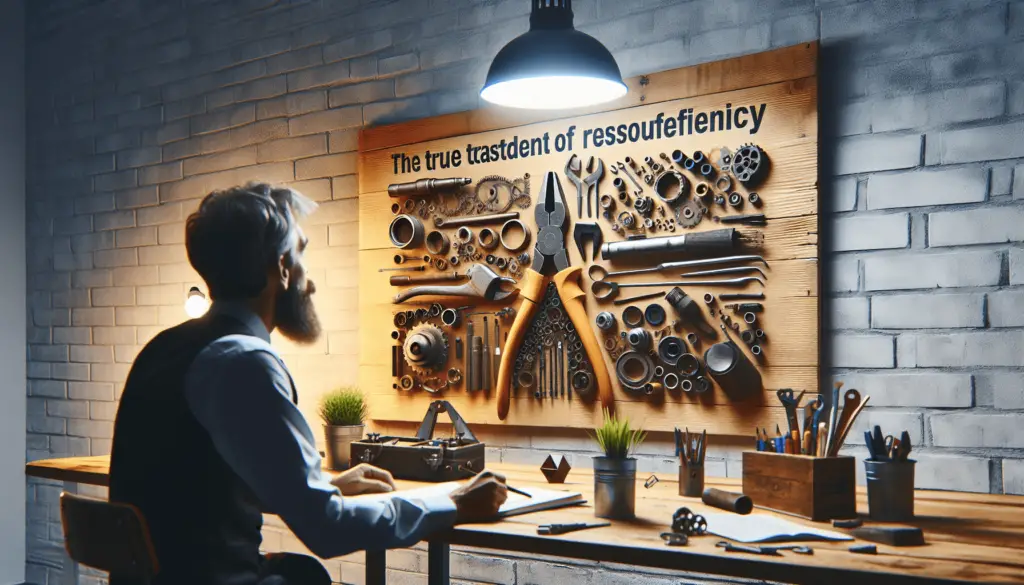Crafting DIY Tools And Equipment From Scrap Materials
Have you ever wanted to create your own tools and equipment using scrap materials that you may have lying around? In this article, we will explore how you can repurpose everyday items to make useful tools for your DIY projects. Let’s get started!

Benefits of Crafting DIY Tools from Scrap Materials
When you craft your own tools and equipment from scrap materials, you not only save money but also reduce waste by repurposing items that would otherwise end up in a landfill. Additionally, DIY tools allow you to customize your equipment to suit your specific needs and preferences.
Crafting your own tools can be a rewarding and satisfying experience, knowing that you were able to create something useful with your own two hands. It can also be a fun and creative way to challenge yourself and learn new skills.
Saving Money
By using scrap materials to create your tools and equipment, you can significantly cut down on the costs associated with purchasing brand new items. Many common household items can be repurposed into tools, saving you money in the long run.
Crafting DIY tools from scrap materials is not only cost-effective but also environmentally friendly. By reducing the demand for new products, you are contributing to a more sustainable way of living.
Customization
One of the main advantages of crafting your own tools is the ability to customize them to fit your needs perfectly. When you make your tools, you can adjust the size, shape, and features to suit the specific requirements of your DIY projects.
Having tools that are tailored to your preferences can make your projects more efficient and enjoyable. You can create tools that are ergonomic, easy to use, and designed specifically for the tasks you perform most often.
Common Scrap Materials for Crafting DIY Tools
Before you start crafting your own tools and equipment, it’s essential to know which scrap materials are commonly used for DIY projects. Here are some of the most common materials that you can repurpose for crafting tools:
Wood
Wood is a versatile material that can be found in many households. Old furniture, scrap lumber, and wooden pallets are excellent sources of wood for crafting DIY tools. You can use wood to create handles, bases, and other components for your tools.
Woodworking tools such as saws, hammers, and chisels are commonly made from wood. With some basic woodworking skills and tools, you can easily create custom wooden tools that are durable and functional.
Metal
Scrap metal is another popular material for crafting DIY tools and equipment. Old car parts, metal pipes, and discarded hardware can be repurposed to create a wide range of tools, including pliers, wrenches, and screwdrivers.
Metalworking tools such as files, hacksaws, and drills are essential for working with metal materials. By repurposing scrap metal, you can create custom metal tools that are sturdy and long-lasting.
Plastic
Plastic is a lightweight and durable material that is commonly used in a variety of DIY projects. Old containers, bottles, and packaging materials can be repurposed to create custom tools and equipment. Plastic tools are lightweight and easy to handle, making them ideal for tasks that require precision and agility.
Plasticworking tools such as heat guns, saws, and drills are designed specifically for working with plastic materials. With some basic skills and creativity, you can craft custom plastic tools that suit your specific needs.
Fabric
Fabric scraps can also be repurposed for crafting DIY tools and equipment. Old clothing, bed sheets, and curtains can be transformed into tool pouches, holders, and covers. Fabric tools are soft, flexible, and easy to work with, making them ideal for protecting and organizing your tools.
Sewing tools such as needles, thread, and scissors are essential for working with fabric materials. By repurposing fabric scraps, you can create custom fabric tools that are stylish and functional.
Essential Tools for Crafting DIY Tools
Before you start crafting your own tools and equipment, you will need a basic set of tools to get started. Here is a list of essential tools that you will need for crafting DIY tools:
| Tool | Description |
|---|---|
| Saw | Used for cutting wood, metal, and plastic materials. |
| Hammer | Used for driving nails and securing components together. |
| Drill | Used for drilling holes in wood, metal, and plastic materials. |
| Screwdriver | Used for tightening and loosening screws in various components. |
| Pliers | Used for gripping, bending, and cutting wires and other materials. |
| Sandpaper | Used for smoothing rough edges and surfaces of materials. |
| Tape Measure | Used for measuring lengths, widths, and depths of materials. |
| Utility Knife | Used for cutting and shaping various materials with precision. |
Having the right tools at your disposal will make crafting DIY tools more efficient and enjoyable. Make sure to have a well-equipped toolbox with all the essential tools for your DIY projects.
Examples of DIY Tools Crafted from Scrap Materials
Now that you have an idea of the common scrap materials and essential tools for crafting DIY tools, let’s take a look at some examples of tools that you can make from scrap materials:
Wooden Mallet
A wooden mallet is a versatile tool that can be used for a wide range of tasks, such as woodworking, metalworking, and general DIY projects. To make a wooden mallet, you will need a piece of scrap wood for the handle and a larger piece for the head. Simply shape the handle and head, and secure them together with glue or screws.
A wooden mallet is a handy tool to have in your workshop, as it can be used for driving chisels, tapping wooden joints together, and other tasks that require a gentle but firm touch.
Metal Scraper
A metal scraper is a useful tool for removing rust, paint, and other debris from metal surfaces. To make a metal scraper, you can repurpose an old piece of metal, such as a file or saw blade. Shape the metal into a flat, sharp edge, and attach a wooden or plastic handle for grip.
A metal scraper is a handy tool for cleaning and preparing metal surfaces before painting, welding, or other metalworking tasks. It can also be used to remove stickers, adhesives, and other stubborn residues.
Plastic Spatula
A plastic spatula is a versatile tool that can be used for mixing, spreading, and smoothing various materials, such as paint, glue, and putty. To make a plastic spatula, you can cut, shape, and sand an old plastic container or lid. The flat, smooth edge of the spatula is ideal for blending and spreading materials evenly.
A plastic spatula is a useful tool for a wide range of DIY projects, such as painting, woodworking, and home improvement. It is lightweight, easy to clean, and inexpensive to make from scrap materials.

Safety Tips for Crafting DIY Tools from Scrap Materials
While crafting DIY tools from scrap materials can be a fun and rewarding experience, it’s essential to prioritize safety throughout the process. Here are some safety tips to keep in mind when making your own tools and equipment:
Wear Personal Protective Equipment
Always wear personal protective equipment, such as safety goggles, gloves, and a dust mask, when working with power tools and sharp materials. Protecting your eyes, hands, and respiratory system is crucial for preventing injuries and exposure to harmful substances.
Use Tools Safely
Follow the manufacturer’s instructions and safety guidelines when using power tools and hand tools. Make sure to maintain a firm grip on tools, keep them sharp and in good working condition, and use them for their intended purposes only. Avoid improvising tools or using damaged equipment to prevent accidents.
Work in a Well-Ventilated Area
Crafting DIY tools from scrap materials may produce dust, fumes, and other airborne particles that can be hazardous to your health. Work in a well-ventilated area with good airflow or use a respirator to reduce your exposure to potentially harmful substances. Keep your workspace clean and organized to minimize the risk of accidents and injuries.
Store Tools Safely
After you have finished crafting your DIY tools, make sure to store them safely and securely. Keep sharp tools out of reach of children and pets, store power tools in a dry place away from moisture, and organize your tools in a designated storage area to prevent accidents and damage. Regularly inspect and maintain your tools to ensure they are in good working condition.
Conclusion
Crafting DIY tools and equipment from scrap materials is a creative and sustainable way to save money, reduce waste, and customize your tools to fit your specific needs. By repurposing common household items such as wood, metal, plastic, and fabric, you can create custom tools that are durable, functional, and uniquely yours.
Before you start crafting your own tools, make sure to equip yourself with the essential tools and safety gear. Practice safe working habits, follow safety guidelines, and prioritize your well-being throughout the crafting process. With a little creativity, patience, and resourcefulness, you can transform ordinary scrap materials into useful tools that will enhance your DIY projects and bring a sense of satisfaction to your craftsmanship. Happy crafting!
